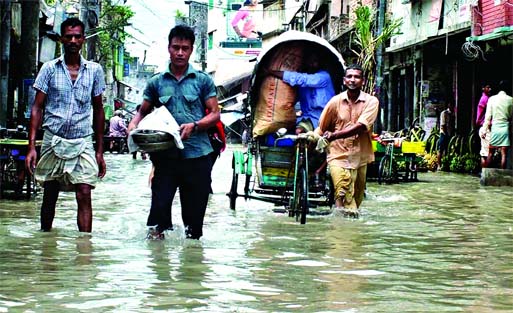
Ehsanul Haque Jasim :
After water began recede in most of the major rivers across the country, the overall flood situation has improved in the northern districts and other parts of the country.
According to the Flood Forecasting and Warning Centre (FFWC), the water level in the Brahmaputra, the Jamuna, the Ganges and the other rivers began to fall, which may likely to continue in next 72 hours. The water level in the Padma River may start to fall today (Saturday).
Md Arifuzzaman Bhuiyan, Duty Officer of the FFWC, on Saturday told The New Nation that the overall flood situation in the northern, central and northeastern parts of the country had improved. The improving trend will continue with further recession in water levels in the major rivers in Kurigram, Lalmonirhat, Nilphamari, Rangpur, Gaibandha, Bogra, Faridpur and Sirajganj districts.
Meanwhile, the flood-hit people are still experiencing untold sufferings because of food and pure drinking water crises. According to reports, most of the flood-hit poor people in the remote areas did not receive relief materials. The poor farmers faced massive losses, as the croplands were submerged.
Many people, who had taken shelter on high lands and different shelter centres sold their cattle and domestic birds at cheaper price to survive. However, erosion in the rivers of the Dharla, the Teesta, the Brahmaputra, the Jamuna, the Ghaghot and some other rivers continues in Kurigram, Gaibandha, Bogra and Sirajganj following the flood. In Kurigram, over 1,50,000 people in parts of nine upazilas in the district remained marooned for days together and many of the affected people are selling their cattle and domestic birds at throw-away prices for want of money to buy food.
Specially, the char people are facing scarcity of foods as well as pure drinking water. Although the district administration has allocated 80 tones of rice for distressed people, many of them are yet to get rice. Sources at district administration said they had already distributed dried among the flood victims. On the other hand, the Brahmaputra River was eroding at Mohanganj under Rajibpur upazila and a good number of houses at Dhakaiyapara, Tangaleapara and Modenerchar were devoured by the river, said correspondent. The Teesta River was eroding at Bazra and the Brahmaputra at Hatia union under Ulipur upazila, leaving the farmers landless, local people said. Executive Engineer of the Water Developmet Board (WDB) Abdul Awal said that they were trying to check erosion putting sand bags in the affected areas. In Sirajganj, the overall flood situation has improved in the district as the water level in Jamuna began to fall. Despite improvement in the flood situation, river erosion was continuing in several parts of the district.
In Faridpur, over 10,000 families in Faridpur Sadar, Sadarpur and Charbhadrasan upazilas are still facing suffering. The flood-hit people did not get relief goods till now.

